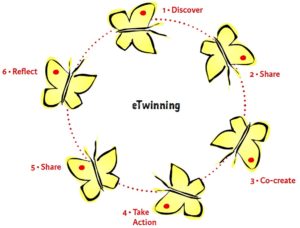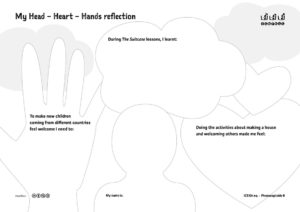| Recommended Resource: ICEKits
Teacher-Created Materials around Picturebooks for Intercultural Citizenship Education in Early ELT Website: https://icepell.eu/index.php/icekits/ Kirsten Birsak de Jersey |
Download PDF
|
Introduction: The ICEPELL Project
The ICEKits are a teaching resource from the Erasmus+ project, Intercultural Citizenship Education through Picturebooks in Early English Language Learning (ICEPELL), created for use with children aged 5-12 years. The project was implemented between September 2019 and August 2022, developed by a consortium of five European partners: Germany, Italy, Norway, Portugal and the Netherlands. Together they designed a professional development course (ICEPro course) for the 61 participating English language teachers, student teachers and teacher librarians. The methodology was explored in two 25-hour teacher development courses in which the participants created their ICEKits based on a template.
The course framework involved the participants collaborating across borders to craft their classroom tasks informed by theory, followed by reflection embedded systematically throughout. The result produced 18 freely downloadable ICEKits (see Figure 1), which form hands-on teaching guides. Each one is based on a picturebook for the promotion of ICE which includes read-aloud stages and learner-centred activities. Finally, the incorporation of review and reflection helps children to become independent learners, whereby they develop their metacognitive abilities ‘to think about “thinking”, to know about “knowing” and to learn about “learning”’ (Ibrahim & Alfernik, 2022, p. 47). This collectively helps to develop their intercultural citizenship competences, which are exemplified in the next section.
Figure 1. The 18 ICEKits: https://icepell.eu/index.php/icekits/
Picturebooks for ICE in Early ELT
Fundamental to the design of each ICEKit is a picturebook which is used to focus on intercultural learning and/or citizenship education in early ELT. According to Ibrahim et al. (2022, pp. 43-44), these domains encompass three ICE-related focal fields: socially responsible behaviour involving interaction with others (1); interaction with local and global issues (2); sense of belonging and knowing about or respecting one’s own, other and/or heritage cultural contexts (3). These focal fields aim to support children to develop competences of ‘interacting effectively and constructively with others, thinking critically, acting in a socially responsible manner and acting democratically’ (European Commission EACEA/Eurydice, 2017, p. 9). Mourão et al. (2022) further explain how the materials are action-oriented to guide both teachers and children to ‘take action and move beyond their classroom walls to engage with their communities’ (p. 27).
The above objective is initiated by picturebook selections based on the criteria from the ICEPELL Picturebook Selection Guide (Ibrahim et al., 2022). This helps teachers to deeply consider the potential of a picturebook for its contribution to ICE in the classroom. The picturebooks selected for the project cover a range of significant topics such as inclusion, for example Perfectly Norman (Percival, 2017) and Strictly No Elephants (Mantchev, 2016), both of which concentrate on a sense of belonging and respectful interaction. Other picturebooks help teachers to encourage children to stand up against bullying, such as One (Otoshi, 2008), which raises awareness of unfair treatment. Teachers can explore issues relating to climate change through the use of Clean Up! (Bryon, 2020) and Here We Are (Jeffers, 2017). Finally, the challenging topic of forced migration can be explored with books such as The Suitcase (Naylor-Ballesteros, 2019) and Welcome (Barroux, 2016), and The Day War Came (Davies, 2019) can help children to empathize with refugee experiences.
The Structure of the ICEKits
Part 1 outlines the target age group and focal fields, followed by the learning outcomes. For example, the ICE outcomes in the ICEKit for Strictly No Elephants give children opportunities to relate to and empathize with others and to consider taking action against injustice. The story is about a little boy and his elephant who are banned from attending the local pet-club day. The language and skills outcomes correlate with the picturebooks, and the language toolbox concentrates on what children can do with the language. For example, the ICEKit for Strictly No Elephants describes a range of emotions and how to be a good friend, which leads to the Taking Action Cycle and the creation of ‘All are welcome’ posters.
Part 2 guides teachers through four well-structured stages which consist of open-ended questions for a series of picturebook read-alouds accompanied by a scaffolded set of activities. Teachers are supported with ideas for helping children to talk about the content of the picturebook during the read-alouds as well as ways to develop children’s skills to review, reflect and take action. Stage 1 focuses on the story context and consists of activities that stimulate curiosity and activate children’s schemata. For example, in the ICEKit for Whoever You Are (Fox, 2007), which is about people around the world, the activities involve photographs of children from many diverse countries, which helps learners to notice similarities and differences. In Stage 2, before reading aloud, attention turns to the picturebook peritextual features through possibilities to prepare the children for the story, such as in the ICEKit for Welcome. The children are asked: When do people say welcome? Why do they say it? Who can you see? (on the front cover) How are they feeling? In this story, three polar bear friends are forced to migrate and they finally find a new home after being turned away by various animals on the way. Stage 3, while reading aloud, forms a firm basis for the follow-up reflect and review activities to assist children with expressing their feelings and thoughts. Prompt questions include: What is the panda’s excuse for rejecting the polar bears? Do you think this is right? Review and reflect activities continue in Stage 4, after reading aloud, to stimulate children to think more deeply about the topic, such as acting out a welcome scene or creating a welcome mat. Part 2 concludes with five reflective questions which are the basis for self-reflection, including for example: What did I do? What did I learn? What actions do I need to take?
Part 3 focuses on taking action which extends beyond the classroom and out into the community. It comprises a six-step activity cycle (see Figure 2) and uses the eTwinning platform for collaboration and communication. This cycle provides an opportunity for classes to work together in a virtual medium that enables them to share ideas, co-create materials and set up projects cooperatively, using English.
Figure 2. eTwinning Taking Action Cycle (Rampone & Ferrari, 2022, p. 33)
Action-taking can occur through direct involvement in the community, such as by helping others, as in the case of a pop-up helpdesk for kind acts in the ICEKit for Be Kind (Miller, 2018), with helpdesk posters and kind words in English. In the ICEKit for Clean Up! the picturebook is about a girl called Rocket who decides to clean up a beach in the Caribbean with the help of her community clean-up crew. Reflecting on hands-on action, children can think about places to clean up in their communities, such as city parks, forests or playgrounds and they create a plan. Taking action can also involve crafting products that help children’s voices to be heard and to share meaningful messages in the community. This may involve posters, booklets and short plays – or painting imaginative messages on rocks or on leaves, as in the case of the ICEKit for Say Something (Reynolds, 2019). In this ICEKit, children can decide on the best places for their ‘say something messages,’ with language support provided to help them to justify their ideas. The children then share their ideas for taking action with partner school classes on eTwinning (or a similar virtual platform). This includes photographs of their activities which helps them to exchange experiences. Each ICEKit concludes with an individual Head-Heart-Hands reflection task (see Figure 3), which stimulates children to review their experiences and reflect on them in ways which are ‘personal, relevant, meaningful and transformative’ (Ibrahim & Alfernik, 2022, p. 52).
Figure 3. Head-Heart-Hands reflection template for ICEKit #4 The Suitcase
The template encompasses the head: to help children to think about their learning; the heart: to consider how they feel about what they have learnt and the hands: to encourage them to ponder ways to take further action.
Final Thoughts
The ICEPELL Project partners have created a pool of imaginative ideas which expose children to authentic language and give them opportunities to use language that is meaningful for and relevant to their own lives. I strongly recommend the ICEKits as a resource which can assist in galvanizing children and teachers alike to embark upon creative, meaningful and unforgettable journeys in ICE.
Bibliography
Barroux. (2016). Welcome. Egmont.
Bryon, Nathan, illus. Dapo Adeola. (2020). Clean Up! Puffin.
Davies, Nicola, illus. Rebecca Cobb. (2019). The Day War Came. Walker Books.
Fox, Mem, illus. Leslie Staub. (2007). Whoever You Are. Harcourt Children’s Books.
Jeffers, Oliver. (2017). Here We Are: Notes for Living on Planet Earth. Harper Collins Children’s Books.
Mantchev, Lisa, illus. Taeeun Yoo. (2016). Strictly No Elephants. Simon & Schuster.
Miller, Pat Zietlow, illus. Jen Hill. (2018). Be Kind. Roaring Brook Press.
Naylor-Ballesteros, Chris. (2019). The Suitcase. Nosy Crow.
Otoshi, Kathryn. (2008). One. Kids Books.
Percival, Tom. (2017). Perfectly Norman. Bloomsbury.
Reynolds, Peter H. (2019). Say Something. Orchard Books.
References
European Commission/EACEA/ Eurydice (2017). Citizenship education at school in Europe – 2017. Eurydice Report. Publications Office of the European Union. https://op.europa.eu/s/xc7x
Ibrahim, N., Becker, C. & Mourão, S. (2022). Picturebook selection. In ICEPELL Consortium, (Eds.), The ICEGuide: A handbook for intercultural citizenship education through picturebooks in early English language learning (pp. 41–46). CETAPS, NOVA FCSH.
Ibrahim, N. & Alferink, M. (2022). Reflecting and reviewing. In ICEPELL Consortium, (Eds.), The ICEGuide: A handbook for intercultural citizenship education through picturebooks in early English language learning (pp. 47–52). CETAPS, NOVA FCSH.
Mourão, S., Kik, N. & Matos, A.G. (2022). From culture to intercultural citizenship. In ICEPELL Consortium, (Eds.), The ICEGuide: A handbook for intercultural citizenship education through picturebooks in early English language learning (pp. 22–29). CETAPS, NOVA FCSH.
Rampone, S. & Ferarri, F. (2022). eTwinning. In ICEPELL Consortium, (Eds.), The ICEGuide: A handbook for intercultural citizenship education through picturebooks in early English language learning (pp. 30–34). CETAPS, NOVA FCSH.
Dr Kirsten Birsak de Jersey is originally from Australia and lives in Austria. She has taught English at pre-primary and primary school levels for over two decades and is lecturer in English at the Pädagogische Hochschule Freiburg (University of Educational Sciences) in Freiburg, Germany. Her research interests include task-based language learning, storytelling, intercultural awareness and teacher education through participatory action research.




